
Dinosaurs in ancient hinduism scriptures
Dinosaurs in Indian scriptures...Surprised...? You wouldn’t find any information on dinosaurs or other similar species in any of the ancient western texts but if you go through the ancient Indian literary texts, you might be able to extract some information on dinosaurs and other species similar to dinosaurs. While going through the verses on embryology in bhagavad purana(read Science in hinduism-Embryology in Bhagavad purana), I came across a verse that possibly refers to species of dinosaurs. After researching a bit, I found more details on dinosaurs from other ancient Indian scriptures as well. From the scriptural point of view, this would be one of the most informative articles on dinosaurs across the internet.
Ever heard of Makara
Have you ever heard of a Sanskrit word ‘Makara’. Don’t confound it with Hindi word ‘Makdi’, meaning ‘spider’. ‘Makara’ was used to refer to a giant amphibian dragon that lived under sea. When I read of a monstrous dragon living beneath sea, then the first creature to pop up in my mind was ‘crocodile’ but the description of ‘Makara’ does not suggest a crocodile. Description and ancient paintings of ‘Makara’ across Asian countries like Cambodia, Burma, Malaysia, Indonesia, Thailand, Japan Vietnam and China presents a literally different picture. You may be surprised to know that the description of ‘Makara’ closely resembles dinosaurs.
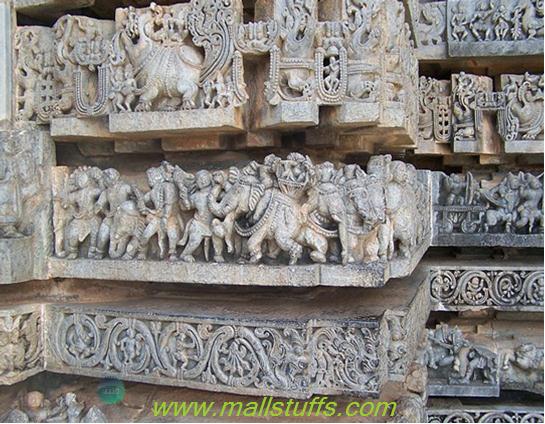
Makara(Top row) of Chennakesava Temple, Belur, Karnataka
‘Makara’ is depicted as the half aquatic-Half animal aggressive monster having head of a crocodile, tail of a peacock, small horns like that of a goat, body of an antelope and paws of a panther.
Makara guarding the temple at Halibedu, Karnataka, India
Makara(Dinosaurs) as the vehicle of god and goddesses
In Scriptures, ‘Makara’ is known as the vehicle of sacred goddess ‘Ganga’-the guardian of the longest river of India. Furthermore, ‘Makara’ is also described as the vehicle of Deity ‘Varuna’-the sea god. Makara is also the emblem of lustful desires and hence, is depicted on the flag (known as Makara-Dhvaja) of KamaDeva(Deity of sex and passion). In Hindu astrology, ‘Makara’ is one of the 12 zodiac signs, known as Capricorn in English.
Scriptures says Deity ‘Varuna’ as the only fearless one who controls the ‘makara’ and can defeat the ‘Makara’. This description clearly implies that ‘makara’ is not crocodile since crocodile can be defeated by even a common well-trained man.
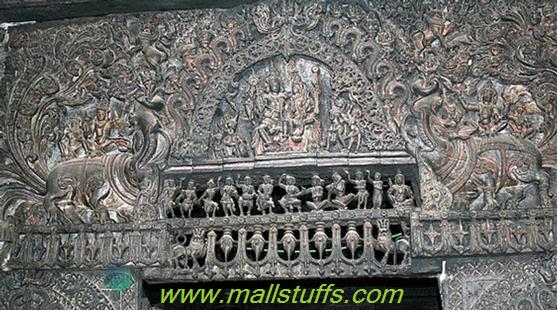
Makara on lentil of sambor prei kuk temple,Cambodia
Makara(Dinosaurs) in ancient Indian scriptures
According to Mahabharata, Makara and Timingila(Shark or whale) were the two powerful sea creatures that lived very deep within the sea along with similar huge creatures. For example, consider the below verse
Verse 168.3, Vana Parva, Mahabharata
“timingilah kacchapasca tatha timi timingilah
makarascatra drsyante jale magna ivadrayah”
Translation: “There were seen Timingilas, tortoises, Timi-timingilas and Makaras, that were like great rocks submerged in the water.”
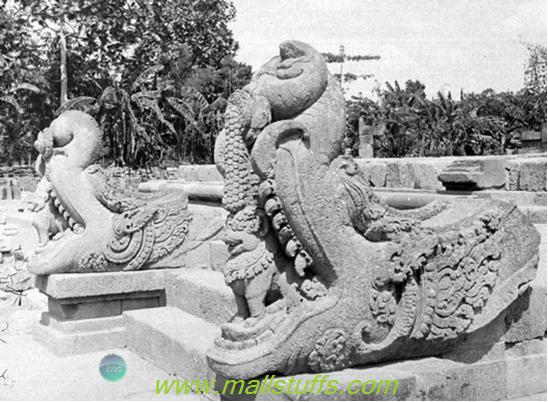
Makara of candi kalasan temple, Indonesia
Also, There are many other texts like susruta samhita, bhagavad purana and bhagavad gita that depicts ‘Makara’ and ‘Timingila’ as the most dreadful amphibian species. For example consider the below verse
Chapter 45, Susruta Samhita
timi-timingila-kulisa-pakamatsya-nirularu
nandi-varalaka-makara-gargaraka-candraka
mahamina-rajiva prabhrtya samudrah
Translation:
"The Timi, Timingila, Kulisa, Paka-matsya, Nirularu, Nandi-Varalaka, Makara, Gargaraka, Candraka, Maha-mina, and Rajiva etc, constitute the family of marine fish."
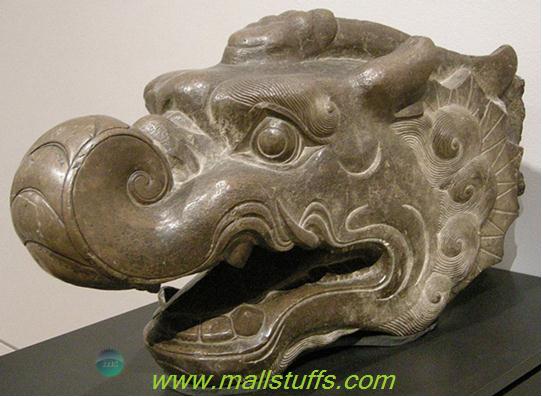
Makara head found in northern Qi dynasty, China
In bhagavad gita, Lord Krishna used ‘Makara’ to represent entire aquatic species thus referring ‘makara’ as the king of all aquatic species.
Verse 31, Chapter 10, Bhagavad-gita
pavanah pavatam asmi ramah sastra-bhrtam aham
jhasanam makaras casmi srotasam asmi jahnavi
Translation:
“Of purifiers I am the wind. Of the wielders of weapons I am Rama. Amongst aquatics I am the makara and of rivers I am the Ganga.”
In Srimad Bhagavatam, ‘Makaras’ and ‘Timingila’ are explicitly stated as dangerous predators that attacked sage ‘Markandeya’
ksut-trt-parito makarais timingilair upadruto vici-nabhasvatahatah
tamasy apare patito bhraman diso na veda kham gam ca parisramesitah
Translation:
“Suffering from hunger and thirst, attacked by Makaras and Timingila and battered by the waves and the wind, Markandeya wandered through the infinite gloom that enveloped him. Overcome by exhaustion, he lost all sense of direction and could not ascertain what the sky was and what the earth was."
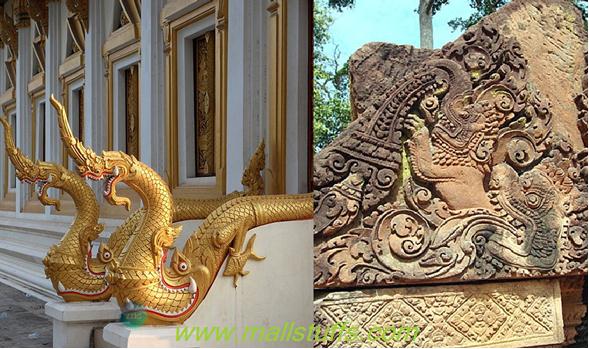
Left is makara of wat that phun(loas) and right is makara of Banteay Srei, Cambodia
Does Makara refers to dinosaurs of Eocene or Cretaceous Periods
Most of the verses in Indian scriptures are in poetical form and so naturally, the author/poet used allegories to represent different situations, objects, scenarios etc. Considering this point, if we apply the above verses to modern scientific findings, we can easily come to the conclusion that ‘Makara’ referred to a species of dinosaurs called ‘Ambulocetus’-(the most dangerous predator of Eocene Period) or ‘Pliosaur’-(the most dangerous predator of Cretaceous Periods). The first fossil of ‘Pliosaur’, estimated to be 155 millions old, was found in Dorset, England in 2003.
Famous Paleontologist ‘Richard Forrest’ in an interview to BBC said “This is an iconic specimen - one of the most exciting we have seen in years. It was probably the most fearsome predator that ever lived. Standing in front of the skull you can imagine this enormous beast staring straight back at you, fixing you with its binocular vision, and attacking. This creature bulky body was powered in waters by four paddle-like limbs that has never been found and may not have fossilized”
On ‘Ambulocetus’, reports describe it as an amphibian creature that existed 60 million years ago. Fossil of Ambulocetus found in Pakistan, is said to be of a time when the land mass of Indian subcontinent was slowly drifting from Africa toward the continental shift of Asia.
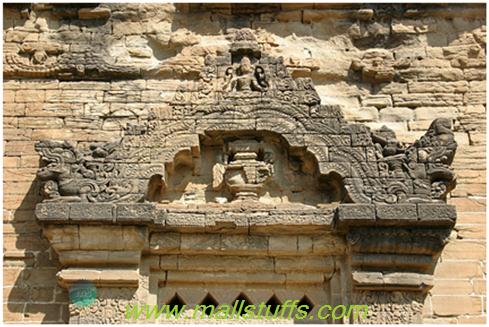
Makara at Nanpaya Temple, Burma
What about other species of dinosaurs?
Now your mind may be wobbling up with many questions like “Makara and timinglas are fine but if Indian ancient scriptures really have description about dinosaurs, then why not the details of other huge creatures that roamed on earth”.
Well, the answer to this specific question is that Ancient scriptures do refer to many other mammoth creatures. However the information is limited since such texts were composed for spiritual reasons and not as entertaining books/stories on dinosaurs. You may be aware that Indian scriptures are full of stories on fights between gods and demons. In such battles, both demons and gods are shown as seated on their specific vehicle, mostly a deadly predator. One of the verses that state the use of strange creatures in battles is as follows
Chapter 8, Verse 10-12, Bhagavad Purana
grdhraih kankair bakair anye syena-bhasais timingilaih
sarabhair mahisaih khadgair go-vrsair gavayarunaih
sivabhir akhubhih kecit krkalasaih sasair naraih
bastair eke krsna-sarair hamsair anye ca sukaraih
anye jala-sthala-khagaih sattvair vikrta-vigrahaih
senayor ubhayo rajan vivisus te ’grato ’gratah
Translation
“O King, some soldiers fought on the backs of vultures, eagles, ducks, hawks and bhasa birds. Some fought on the backs of timingilas, which can devour huge whales, some on the backs of sarabhas, and some on buffalo, rhinoceroses, cows, bulls, gavaya [jungle cows] and arunas. Others fought on the backs of jackals, rats, krkalasa, rabbits, human beings, goats, black deer, swans and boars. In this way, mounted on animals of the water, land and sky, including animals with deformed bodies [vikrta-vigraha], both armies faced each other and went forward.”
Some of the creatures in the above verse are not identifiable. Nobody knows the English or Hindi equivalent of animals like ‘bhasa’, ‘krkalasa’, ‘gavaya’, ’sarabhas’, ‘arunas’, and ‘vikrta-vigraha’. All of them are said to be aggressive predators. These may be the names of extinct species of dinosaurs or some other extinct species.
Furthermore, in sanskrit, ‘vikrta-vigraha’ means ‘Animals with distorted body’, krkalasa means ‘Big lizard or chameleon’ and gavaya means ‘wild bull’. So, when the opponent is riding on an elephant, rhinoceros or wild buffalo, one would definitely opt for a big lizard like dinosaurs as his vehicle... isn’t it?
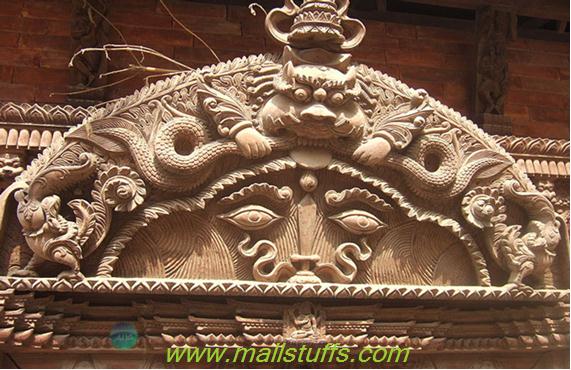
Makara and kirtimukha at Hindu temple in kathmandu, Nepal
Species of dinosaurs in Mahabharata
You may say that one example is not enough...So, Let us take one more, this time from Mahabharata.
In Mahabharata, there is a mention of dinosaurs in symbolic form of dangerous serpents. There is description of species that throws fire (Dragon) and species that can kill a live tree with one just bite.
Exact Story is as follows
Parikshit, Son of Arjuna, was cursed by a sage to die of snake bite. After his death, Son of Parikshit, ‘Janamejaya’ decided to take vengeance against the whole serpent dynasty (dragons and dinosaurs belongs to serpents race). He organized a grand sacrifice to destroy all serpents dwelling on earth. Many serpents died in this yagna and just before the entire serpent race was about to wipe out, Janamejaya was stopped by a learned sage named ‘Astika’, Son of Naga mother and Brahmin father. The mass sacrifice that started on the banks of river Arvind at Bardan (Presently Parham, shortcut of ‘Parikshitgarh’) ended all the enmity between the pandavas and nagas. Masonry tank built by Janamejaya to mark this event can still be seen at Parikshit kund(commonly known as Gowdvana) at Mainpuri district in Parham.
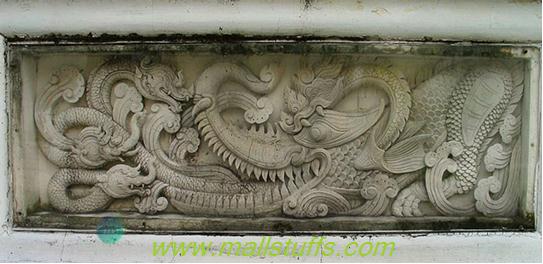
Left shows the Makara and Nagas of Wat suthat, Bangkok, Thailand
The exact verse that describes some dinosaur like wild creatures are as follows
"Preists lit fire and chanted mantras to start the sacred ceremony of yagna. When the flames were high and sound of mantras vibrated the environment, all sorts of serpents in different colors started spitting venom and combusted into ashes. Hundreds and thousands of snakes, some of length spanning several yojana(1 yojana=8-15 km) got dragged in fire and burned down into ashes. These serpents are
1) Descendants of Vasuki (Kotisa, Hiranyavahu, Purna, Cala, Pala, Halmaka, Manasa, Kaunapa, Pichchala, Kalavega, Carana, Cakra, Kakshaka, Prakalana and Kaladantaka)
2) Descendants of Takshaka (Mandalaka, Puchchandaka, Ravenaka; Uchochikha, Pindasektri, Bhangas, Carava, Vilwatejas, Sili, Salakara, Virohana; Muka, Pravepana, Sukumara, Sisuroman, Mudgara, Suroman and Mahahanu)
3) Descendants of Iravati (Paravata, Pramoda, Pandara, Parijata, Krisa, Harina, Sarabha, Meda, Vihanga and Sauhatapana)
4) Descendants of Kauravya (Pratara, Eraka, Veniskandha, Kumaraka, Vahuka, Kundala Veni, Dhurtaka, Sringavera, and Astaka.)
5) Descendants of Dhritarashtra (Sankukarna, Kuthara, Sukhana, and Shechaka; Pitharaka, Purnamukha, Purnangada, Sakuni, Dari, Amahatha, Prahasa, Sushena, Kumathaka, Bhairava, Mundavedanga, Pisanga, Vyaya, Udraparaka, Vegavat, Pindaraka; Raktanga, Sarvasaranga, Samriddha, Patha, Rishabha and Vasaka;
6) Descendants of Varahaka(Viranaka, Tarunaka, Chitravegika, Maniskandha, Suchitra, Parasara and Aruni).
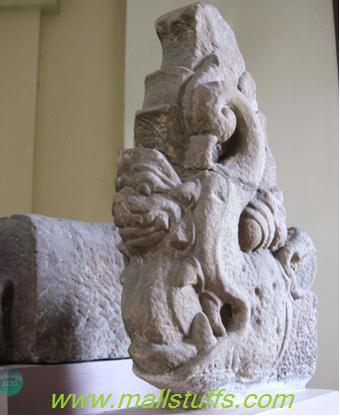
Pic from national museum of Vietnam that shows a naga emerging from mouth of makara
Species of dinosaurs in Ramayana
In Ramayana, there is a mention of an event where King Vibhishana of lanka confronted mighty creatures that were troubling mankind on earth. Further, sage Valmiki mentions giant flying horses guarding the city of Lanka. For me, Giant horses certainly sounds like dinosaurs, especially the ones that has the distinctive characteristic of flying in the air. Ramayana is said to be 18 million year old story. So, it is quite possible that dinosaurs or similar other creatures ruled earth during those times. (also read Neanderthal man and hominid species in Ramayana )
There are two more stories on species of dinosaurs from bhagavad purana. Since these lengthy stories would extend this article further, I would take it in a separate article.
From the above verses, description of dinosaurs and other similar species is quite evident in ancient Indian literary texts.
Vedic explanation to existence of dinosaur’s species
According to Bhagavad Purana, combination of yugas called as ‘manvantaras’ repeat indefinitely where each manvantaras is characterized by its own set of plants and animals. In Total, Vedas states 84,00,000 different species of animals. Some of the animals and plants of previous ‘manvantaras’ become extinct in next ‘manvantaras’ and then are revived again after series of ‘manvantaras’. Additionally, Bhagavad Purana states that extinct species of previous ‘manvantaras’ are replaced by new species in next ‘manvantaras’ and this process of replacement is known as ‘Transmigration of souls’.
Since only a small portion of this vast earth has been excavated and examined, many of the species including human species are still unknown to us. But the series of findings has forced all the scientists to refute Darwin concept of evolution thus paving the path for Vedic concept of ‘Soul Transmigration’, the concept that cannot be proved scientifically. (Also read Scientific explanation of Hindu cosmology and reincarnation)
Short discourse on Transmigration of souls
Life is not simply the scientific formula of some biochemical events; instead, life is created by a spark of the spirit that turns the body composed of five elements into a living being. As long as soul lives in the body, body is alive and no sooner does it leaves the body, the material body starts to decompose back to five elements.
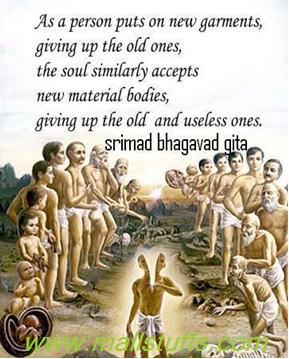
Though soul drives the body, the relationship between the two is not eternal but only for one lifetime, the time period till which the soul stays inside the human body. After that time period, soul takes up a new body which may be of an animal/ plant or women/men depending upon the karma in his/her previous life. Until the soul understands the transcendental connection with the supreme god and become self-realized, the soul continues to transmigrate from one species to another. This process is ‘Transmigration of souls’ or cycles of birth and death.
<>
Dinosaurs and all species follow the cyclic pattern of extinction
Vedic theory states that Fish or any other aquatic animal, when brought on earth develops intense desires to breathe like an amphibian. As a result, they are born as amphibian in their next birth. With desires of becoming dangerous predators, they become lizards or snakes in their next life. Tired of slow motion, they develop a desire of running thus transmigrating into monstrous predators like dinosaurs in their next life. After series of births in desirable forms, they become extinct and the cycle starts from first phase again.
Vedic theory also states the degrading level of species in each yuga. i.e Species become smaller and spiritually less inclined in each degrading yuga. This is why we don’t find giant humans/animals in this yuga though there are enough evidences of both giant humans and giant animal species like dinosaurs.
Did Human and dinosaurs co-exist?
In Vedic civilization, humans were spiritually advanced and not materialistically advanced. Quite possibly, predators-like dinosaurs lived in places far off from human settlements while other dinosaurs lived along with humans. Limited use of technology and lack of materialistic desires may have bolstered the co-existence of humans and dinosaurs.
<>
Recent study of dinosaur dung and fossil fuel in central India (especially Pisdura village of Nagpur district) by scientists from US, china and India has concluded that “Few species of Dinosaurs in India fed on rice and a variety of rice was grown in India millions of years ago during the Cretaceous and Eocene period”, thus pushing back the date of Indian civilization to at least 65 million years old, the time when the landmass of Indian subcontinent was situated very close to continental shelf of Africa.
<>
Recently, when huge dinosaur’s eggs were excavated in Gujarat, villagers thought those to be the boon of Lord Shiva and started worshipping such fossilized eggs as shiv-Lingam...
Huh...Typical Hindus...
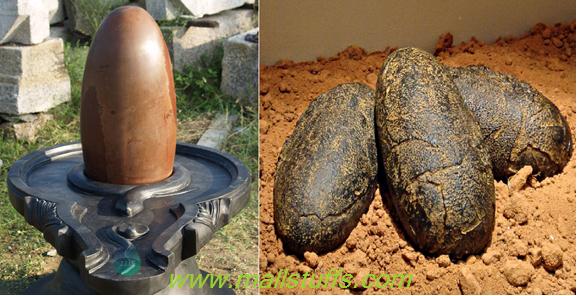
Left is Shiv-Lingam and on the right is dinosaur’s eggs that illiterate villagers mistakenly thought as Shiv-Lingam...
Note: Central India is known as the largest dinosaur breeding site in the world from where the largest number of eggs and nest from a single period of time (68 to 65 million years ago) were excavated. Gold medalist geologist ‘Prithiraj Chungkham’ postulated the journey of dinosaurs from all around the world to India in order to nest or lay eggs in India.
<>
Why scientists are mum on findings of dinosaurs
Theory of Co-existence between humans and dinosaurs is slowly embraced by scientists all over the world but are reluctant to admit so under the pressure of atheistic communist empire that strictly wants to hold on dogma of evolution. Under the pressure of Christian evangelists and preachers, some of the modern scientists are quite reluctant to reveal all the truth related to fossil discoveries that contradict the biblical claim of this universal creation just 6000 years ago. Moreover, such frequent changes in scientific theories would undermine the significance of science/scientists and would question the progress of science. Some of the scientists are reluctant to admit faults in science and are fooling others to believe in false theories like ‘theory of evolution’.
So, the modern scientist’s claim of dinosaurs being the exclusive ruler of this earth is quite misleading and quite questionable.
<>
Check the footprints of human and dinosaurs in the above video from 10min.
Below Stones from Peru which was part of the ancient Vedic empire reveals the co-existence of humans and dinosaurs like creatures
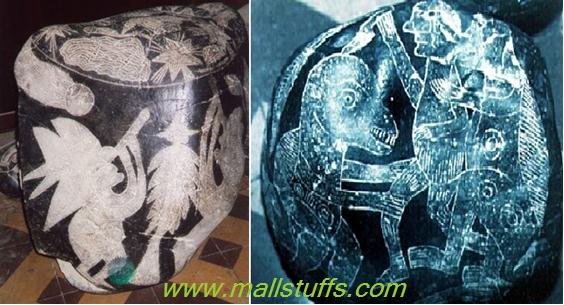
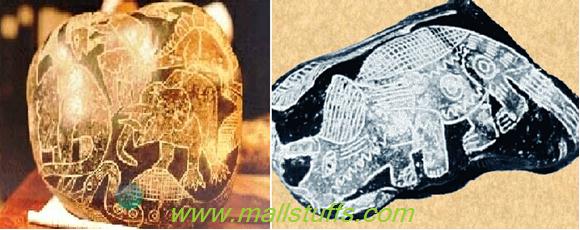
Conclusion:
If Dinosaurs existed in India during ancient times, then naturally it would find a place in written literature. Now that it has been proved that dinosaurs existed in vast regions of India, we can definitely say that the animals mentioned in ancient literature like Srimad Bhagavatam are species of dinosaurs. This also dates the literary texts of ‘Srimad Bhagavatam’ to be millions of years old, last thoroughly compiled in 1900 BC. Description of extinct animals proves that the author of such texts were either aware of such creatures because of the information passed by their ancestors/gurus through ages or they lived during the age when such creatures roam across the geographical regions of earth. This once again validates the superiority and authenticity of Indian scriptures.
In next article, I will post stories on dinosaur like species from bhagavad purana.
Note: Images used on this website
are either a production of Bhaktivedanta Book Trust(https://www.krishna.com), Iskcon
Foundation or were found in google search under "Free to use and share". If any
of the images presented here violates copyright issues or infringes anyone copyright
or are not under "Fair use", then please bring it to our notice. Read
Disclaimer for more.
Share this to your friends. One of your friend is
waiting for your share.
Related Articles
Dinosaurs in ancient hinduism scriptures
srila praphupada conversation with a reporter on Darwin theory of evolution
Science in Hinduism-Creation of Humans and third type of lord vishnu
How many species on earth?
Post Comment